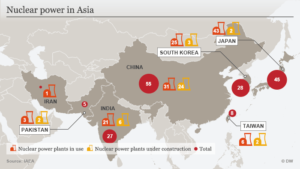by Zafar Iqbal Yousafzai 26 January 2022
The development and deployment of nuclear technology are bringing a shift around the world. South Asia is no exception. The deployment and quest for sophisticated weapons may alter the dynamics of nuclear deterrence. The China-US and Russia-US rivalry have a deep impact on the South Asian strategic dynamics. The non-nuclear long-range precision strike capabilities, advanced missile defense systems, hypersonic weapons, counter space race, and cyber warfare are new challenges for deterrence and stability in the region.
India has always sought advanced strategic weapons that have indulged the region in an arms race. Whether it was the quest for nuclear weapons in the 1960s or the nuclear deal with the US in the new millennium, it has badly affected the region and has caused a sense of insecurity in Pakistan that has compelled Pakistan to go for the same in order to attain balance of power. Thus, the arms race is going more acute than in any other area of the world. This vicious cycle is very difficult to break in the current circumstances.
The advent of strategic non-nuclear weapons and its race between the major powers also inclined Indi and Pakistan to seek the same. Though both the states are quite behind the major powers in this field, it is not possible to stop them from acquiring it. If on one hand, India is seeking sophisticated technology, on the other hand, China is building and developing its own sophisticated weaponry and technology. China is building its technology to compete with the United States, India is following China to counterbalance while Pakistan makes efforts for the balance of power in South Asia in order to avoid any conflict that may result due to any strategic imbalance.
Hence, the US-China competition and then their relationship with New Delhi and Islamabad also provide for the strategic transformation of South Asia. When India signed the civil nuclear deal with the United States, it had a huge impact on Pak-US relations by deteriorating it. Similarly, it resulted in close cooperation between Beijing and Islamabad. A few years after the Indo-US nuclear deal, the China-Pakistan Economic Corridor project and Belt and Road Initiative surfaced which further strengthened China-Pakistan relations.
Following the US withdrawal from Afghanistan, US-Pakistan relations are at their lowest ebb. However, the US needs Pakistan to cooperate in counter-terrorism efforts and Afghanistan. Afghanistan’s situation is still uncertain after five-month since the Taliban has taken control of the country. The US as well as the international community has eyes on the Taliban administration what direction they set their channels. Besides, the US wants to keep its contact alive with the Pakistan army. However, Pakistan wants a stable and smooth relationship with the United States as well as with China. Though US-Pakistan relations are not smooth at the moment, these are decades old and have a long history of cooperation during various times especially Cold War and the war on terror. Pakistan is also one of the main recipients of US aid. Yet at the same time, China is a reliable strategic partner. The main thing that is lacking in US-Pakistan relations is trust. The trust deficit is one of the main factors that provide for irritants in US-Pakistan relations all the time.
Though India shares concerns about the Chinese rise with the United States in the Indo-Pacific India is not willing to serve the US interests. India wants to maintain its economic growth by avoiding any serious conflict. However, her strategic culture and quest for sophisticated weapons are disturbing the strategic balance in South Asia. Besides the nuclear arms race, the developments of non-nuclear technologies also contribute to the geopolitical competition in the region and will have an impact on the future of the region as well. Still, there is time with India to avoid unnecessary quest for weapons and technology and save the region from any instability that could lead the region to war and destruction.

